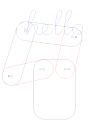SCARA

The SCARA acronym stands for Selective Compliance Assembly Robot Arm or Selective Compliance Articulated Robot Arm.
In 1981, Sankyo Seiki, Pentel and NEC presented a completely new concept for assembly robots. The robot was developed under the guidance of Hiroshi Makino, a professor at the University of Yamanashi. The robot was called Selective Compliance Assembly Robot Arm, SCARA. Its arm was rigid in the Z-axis and pliable in the XY-axes, which allowed it to adapt to holes in the XY-axes. [1] [2]
By virtue of the SCARA's parallel-axis joint layout, the arm is slightly compliant in the X-Y direction but rigid in the 'Z' direction, hence the term: Selective Compliant. This is advantageous for many types of assembly operations, i.e., inserting a round pin in a round hole without binding.
The second attribute of the SCARA is the jointed two-link arm layout similar to our human arms, hence the often-used term, Articulated. This feature allows the arm to extend into confined areas and then retract or "fold up" out of the way. This is advantageous for transferring parts from one cell to another or for loading/ unloading process stations that are enclosed.
SCARAs are generally faster than comparable Cartesian robot systems. Their single pedestal mount requires a small footprint and provides an easy, unhindered form of mounting. On the other hand, SCARAs can be more expensive than comparable Cartesian systems and the controlling software requires inverse kinematics for linear interpolated moves. This software typically comes with the SCARA though and is usually transparent to the end-user.
Most SCARA robots are based on serial architectures, which means that the first motor should carry all other motors. There also exists a so-called double-arm SCARA robot architecture, in which two of the motors are fixed at the base. The first such robot was commercialized by Mitsubishi Electric. Another example of a dual-arm SCARA robot is Mecademic's DexTAR educational robot.[3]
Animations[4]
See also
References
- ^ Assembly robot US Pat. 4,341,502 https://docs.google.com/viewer?url=patentimages.storage.googleapis.com/pdfs/US4341502.pdf
- ^ Westerland, Lars (2000). The Extended Arm of Man, A History of the Industrial Robot. ISBN 91-7736-467-8.
- ^ "Archived copy". Archived from the original on 2015-07-26. Retrieved 2015-07-29.
{{cite web}}: Unknown parameter|deadurl=ignored (|url-status=suggested) (help)CS1 maint: archived copy as title (link) - ^ Simionescu, P.A. (2014). Computer Aided Graphing and Simulation Tools for AutoCAD users (1st ed.). Boca Raton, Florida: CRC Press. ISBN 978-1-4822-5290-3.
External links
- Why SCARA? A Case Study – A Comparison between 3-axis r-theta robot vs. 4-axis SCARA robot by Innovative Robotics, a division of Ocean Bay and Lake Company




